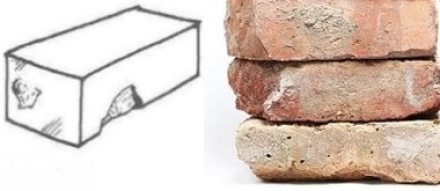Types of Defects in Bricks and their Identification
Following are the different types of defects generally found in bricks:
1. Over burning of bricks
When bricks over-burn, soft molten mass is produced and the brick will its shape along with other designated requirements.

Fig.1: over burnt bricks
2. Under burning of bricks
- When bricks are not burnt to cause complete vitrification, the clay is not softened because of insufficient heat and the pores are not closed.
- Consequently, bricks with low compressive strength and high-water absorption will be produced.
- They produce a dull sound when struck against each other.
- Finally, such bricks are not recommended for construction works

Fig.2:under burnt bricks
3. Bloating of bricks
Bloating of bricks is spongy swollen mass over the surface of burned bricks. Presence of excess carbonaceous matter and Sulphur in brick-clay is the main cause of bloating.

Fig.3:bloating of bricks
4. Black core
Improper burning is the prime cause of brick black core. Bricks, which contains bituminous matter or carbon and they are not completely removed by oxidation, will commonly experience such problem.

Fig.4:black core brick
5. Efflorescence
Presence of drying grey or white powder patches on the brick surface is the efflorescence indicator. This defect is caused because of alkalis present in bricks. When bricks come in contact with moisture, water is absorbed and the alkalis crystalize. Lastly, efflorescence can be minimized by selecting proper clay materials for brick manufacturing, preventing moisture to come in contact with the masonry, by providing waterproof coping and by using water repellent materials in mortar and by providing damp proof course.

Fig.5:efflorescence on bricks
Straight cracks
Straight cracks at right angles from one of the long surfaces of the brick will develop. Considerably rapid drying is the cause of straight cracks. Possibly, brick damage occurs even if fired adequately.

Fig.6:brick straight cracking on one of long surfaces
Random cracks
- Cracks initiate arbitrarily on different brick surfaces.
- Differential drying generate shrinkage. then, various lumps of dried materials will shrinkage differently which eventually lead to random cracking.
- additionally, the presence of pebbles in clay mix could lead to random cracking as well.

Fig.7:multiple brick surface cracking in random directions
7. Brick spalling
- Irregular portion of the brick break away of fall off.
- Heating of water inside brick is the cause of spalling

Fig.8:Spalling of bricks
8. Chuffs
The deformation of the shape of bricks due to rain water falling on hot bricks is known as chuffs.
9.Lime blowing
- Disintegration of bricks is the indicator of lime blowing.
- If bricks contain lime lump, then lime blowing is expected. The lime absorb water and expand after its exposure to firing. Consequently, lime blowing will take place.
- Bricks susceptible to lime blowing can be identified by submerging the brick in water. As a result, the brick fractures and powdery lumps will be exposed.

Fig.9:Lime blowing defects
10. Spots
- It is a dark spot on brick surface.
- The presence of iron sulphide in clay brick is the main cause of spots.
- Bricks with sports on its surface is unsuitable for exposed masonry work.

Fig.10:spots in bricks
11. Lamination bricks
- Thin lamina produces on the brick faces which weather out on exposure.
- Entrapped air in the voids of clay is the cause of laminations.
- Such bricks are weak in structure.

Fig.11:Brick lamination
12. Defects in brick size
Oversize bricks
- Brick oversize in width, length, and thickness

Fig.12:oversize brick in all dimensions
- Size defects make bricks lighter than normal bricks
- Oversize in all three dimensions of bricks might cause by under-firing, poor material selection and preparation. For example, presence of too much sand that decline among of drying.
- Oversize in width and length occur due to brick squashing while it is still wet. This may have been occurred when the brick was set down on the ground or drying rack after being molded or when a slop molded brick was pressed to flatten out a distortion.

Fig.13:brick set on the ground cause oversize in length and width
- Oversize in thickness, which is common problem in wire cut bricks, occurs during brick wire cutting. the block of clay is forced through a row of wires. As a result, the force on the wire may cause movement that changes the dimension of the opening which the clay passes through.

Fig.14:over sized bricks during wire cut process
Under-size bricks
- This problem occurs due to several factors for example, faulty mould, presence of too much clay in the batch, using too much water during the mixing stage, and over firing.
13. Defects in brick shape
Slump brick shape
- It occurs when clay mix is considerably wet, so it slumps under its weight.

Fig.15:Defects in brick shape; slump
Rounded corner brick
- Corner breakage between drying and firing may cause this problem.
- Another factor is that, the worker does not push clay into the mould properly.

Fig.16:defects in brick shape; round corner
Lip on bed face
- Excessive clay is not removed from the face of the brick during manufacturing is the cause of presence of lip on brick bed face.
- Leaving flashing around brick top edge border during production process is another factor that led to this issue.
